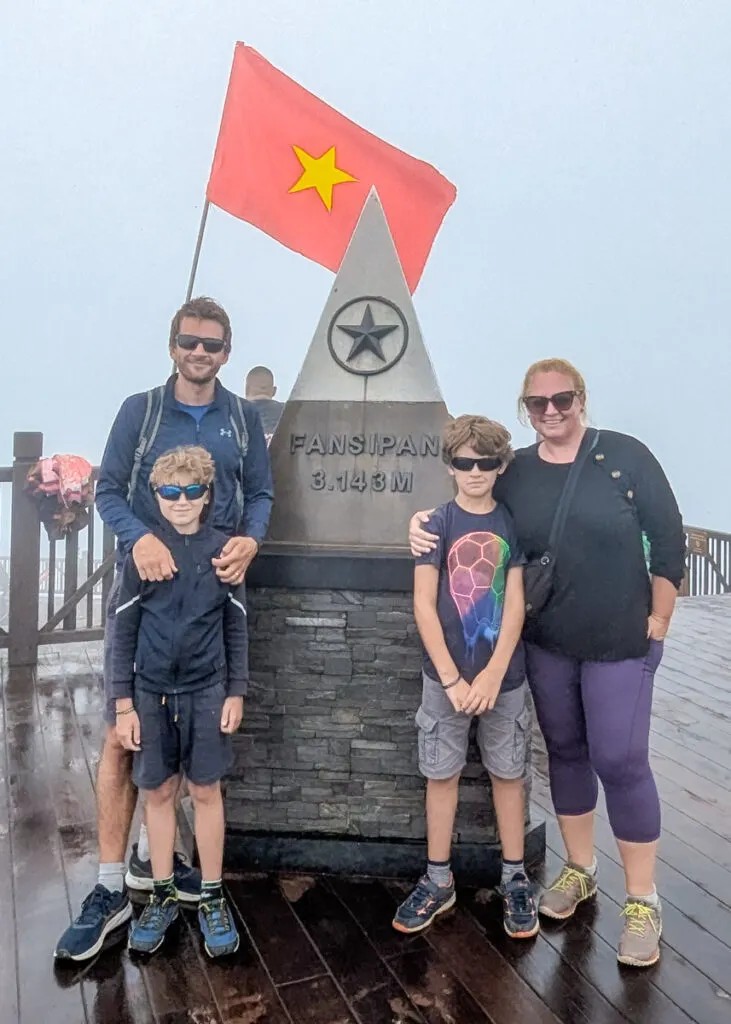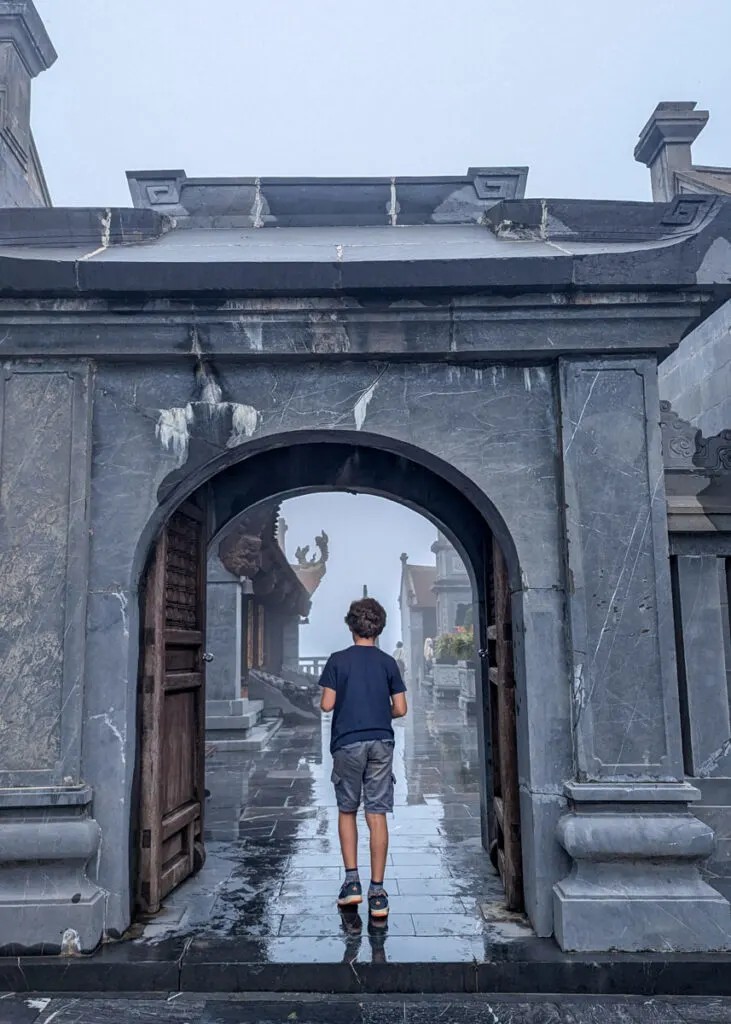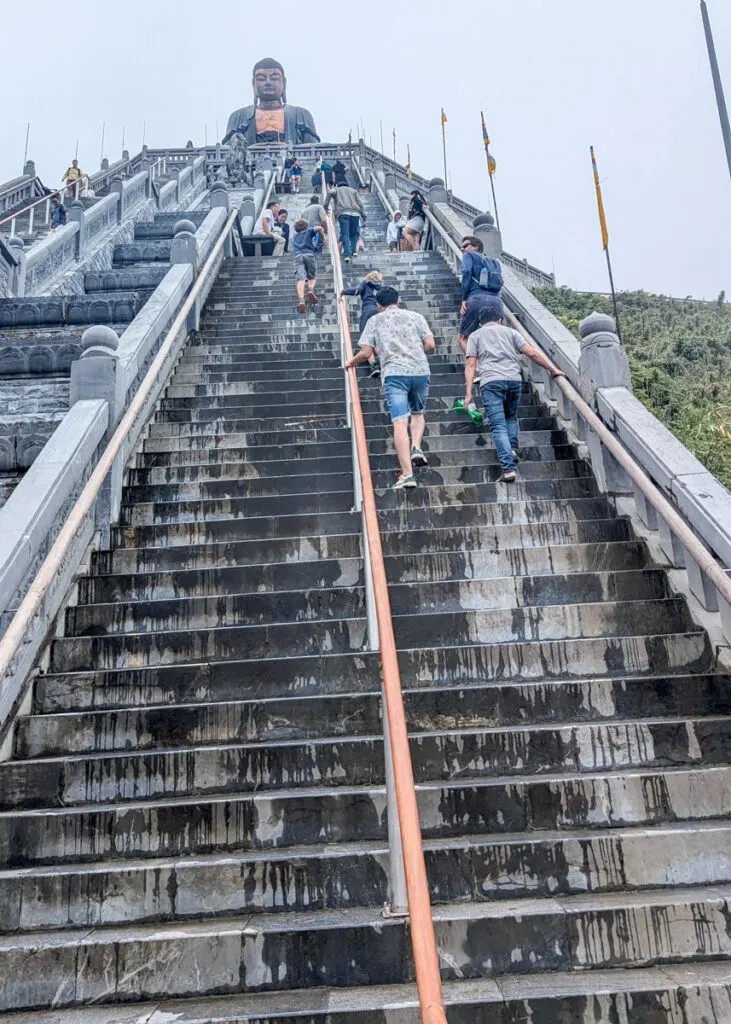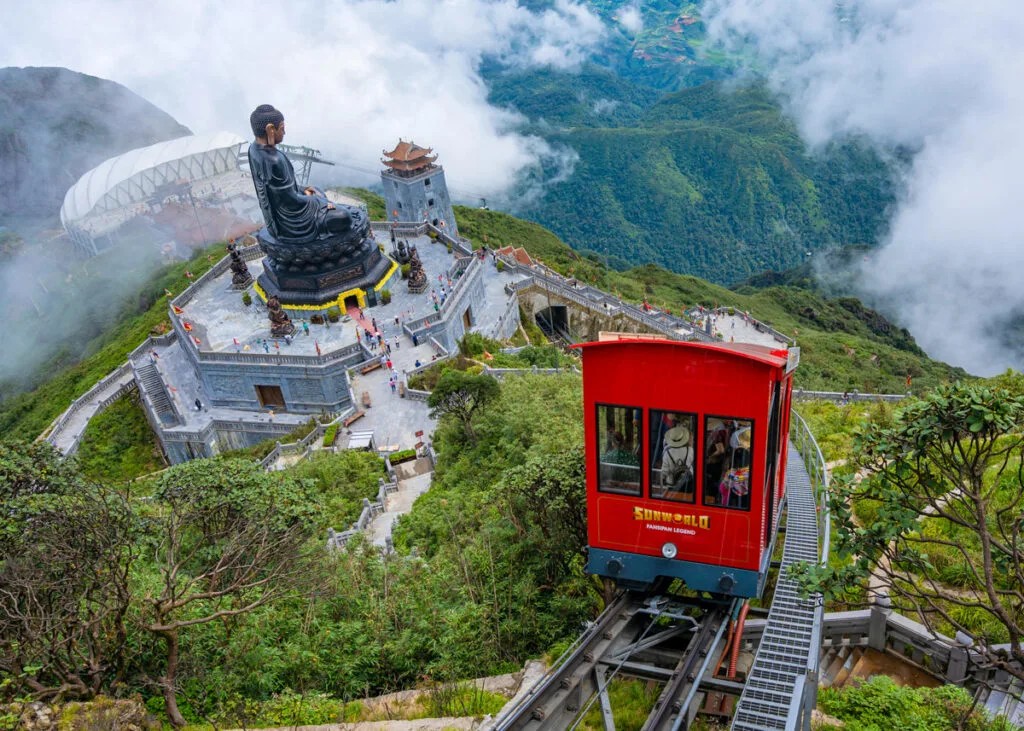Are you planning a trip to Fansipan, the Roof of Indochina, via the cable car and wondering about altitude sickness? Altitude sickness is a potential concern when ascending rapidly to high elevations like Fansipan’s summit. With SIXT.VN, you can travel with peace of mind knowing you are prepared for a safe and enjoyable experience. Discover how to mitigate risks and ensure a memorable visit to this breathtaking destination in Vietnam by getting reliable travel advice.
1. Understanding Altitude Sickness and Fansipan
What is Altitude Sickness?
Altitude sickness, also known as acute mountain sickness (AMS), is a condition that can occur when you ascend to a high altitude too quickly. According to the Institute for Altitude Medicine, AMS is a common ailment affecting travelers who ascend to elevations above 8,000 feet (2,400 meters) without proper acclimatization. The primary cause is the reduced availability of oxygen at higher altitudes, leading to various physiological responses in the body.
How High is Fansipan?
Fansipan stands tall at 3,143 meters (10,312 feet), making it the highest peak in Indochina. While it’s not as extreme as the Himalayan peaks, it’s high enough to pose a risk of altitude sickness for some individuals. The rapid ascent via cable car exacerbates this risk because it bypasses the gradual acclimatization that occurs with hiking.
Cable Car Ascent and Altitude Sickness Risk
The Fansipan cable car whisks you from Sapa town to near the summit in just 20 minutes. This rapid elevation gain means your body has little time to adjust to the decreasing oxygen levels. Therefore, even though you’re not exerting yourself physically, the swift change in altitude can still trigger altitude sickness.
 Fansipan summit with cable car
Fansipan summit with cable car
2. Symptoms of Altitude Sickness to Watch Out For
Common Symptoms
Altitude sickness symptoms can vary in severity. Mild symptoms include:
- Headache
- Dizziness
- Fatigue
- Nausea
- Loss of appetite
- Difficulty sleeping
These symptoms usually appear within 12 to 24 hours of reaching a high altitude.
Severe Symptoms
In more severe cases, altitude sickness can lead to life-threatening conditions such as:
- High Altitude Pulmonary Edema (HAPE): Fluid accumulation in the lungs, causing extreme shortness of breath.
- High Altitude Cerebral Edema (HACE): Fluid accumulation in the brain, leading to confusion, loss of coordination, and eventually coma.
Recognizing Symptoms in Children
Children may have difficulty expressing their symptoms. Watch for signs such as:
- Irritability
- Excessive crying
- Refusal to eat
- Lethargy
Personal Experience Matters
According to the Altitude Research Center, individual susceptibility to altitude sickness varies. Factors such as genetics, pre-existing health conditions, and acclimatization history play a significant role. Pay attention to how you and your travel companions are feeling and don’t hesitate to seek medical attention if symptoms worsen.
3. Assessing Your Personal Risk Factors
Pre-Existing Health Conditions
Certain health conditions can increase your risk of altitude sickness. People with heart or lung problems should consult their doctor before traveling to high altitudes. Conditions like asthma or chronic obstructive pulmonary disease (COPD) can be exacerbated by reduced oxygen levels.
Age and Physical Fitness
While physical fitness doesn’t necessarily protect you from altitude sickness, being in good health can help you cope with the symptoms. Age is not a direct risk factor, but older adults may have a higher likelihood of underlying health issues that increase their vulnerability.
Previous Experiences
If you’ve had altitude sickness before, you’re more likely to experience it again. Consider this when planning your trip and take extra precautions.
Individual Susceptibility
Even among healthy individuals, susceptibility to altitude sickness varies. Some people are simply more prone to it than others. Be aware of your body’s response to altitude and adjust your plans accordingly.
4. Practical Steps to Prevent Altitude Sickness on Fansipan
Gradual Acclimatization (If Possible)
While the cable car offers a quick route to the top, spending a day or two in Sapa (around 1,500 meters or 4,921 feet) before ascending Fansipan can help your body adjust to the altitude. This allows your body to produce more red blood cells, improving oxygen delivery.
Hydration is Key
Dehydration can worsen altitude sickness symptoms. Drink plenty of water in the days leading up to your trip and throughout your visit to Fansipan. Avoid excessive alcohol and caffeine, as they can contribute to dehydration.
Avoid Alcohol and Smoking
Alcohol can interfere with acclimatization and worsen symptoms of altitude sickness. Smoking reduces the amount of oxygen in your blood, making you more susceptible to the condition.
Dietary Considerations
Eat a high-carbohydrate diet. Carbohydrates require less oxygen for metabolism compared to fats and proteins, which can help your body function more efficiently at high altitudes.
Pace Yourself
Even though you’re taking the cable car, take it easy once you reach the summit. Avoid strenuous activities and give your body time to adjust.
Consider Medication
Consult your doctor about medications like acetazolamide (Diamox), which can help prevent altitude sickness. If you’re prone to altitude sickness or have a pre-existing health condition, this might be a worthwhile option.
According to a study by the Wilderness Medical Society
Acetazolamide is effective in preventing and treating AMS. However, it’s essential to discuss potential side effects with your doctor before taking any medication.
 Walking path to Fansipan summit
Walking path to Fansipan summit
5. What to Do if You Experience Altitude Sickness on Fansipan
Recognize Early Symptoms
The key to managing altitude sickness is to recognize the symptoms early. If you experience a headache, dizziness, or nausea, take immediate action.
Descend if Necessary
The most effective treatment for altitude sickness is to descend to a lower altitude. Even a small descent of a few hundred meters can make a significant difference. If your symptoms are severe, don’t hesitate to return to Sapa.
Rest and Hydrate
If your symptoms are mild, rest and drink plenty of water. Avoid further exertion until you feel better.
Oxygen Therapy
The summit of Fansipan has medical facilities that can provide oxygen therapy. If you’re experiencing shortness of breath or other severe symptoms, seek medical assistance immediately.
Medical Assistance
Staff at Fansipan are trained to recognize and assist with altitude sickness. Don’t hesitate to ask for help if you need it. SIXT.VN ensures that all our partnered locations and tours are equipped with necessary emergency protocols.
6. What to Expect at the Fansipan Summit
Weather Conditions
The weather at the summit of Fansipan can be unpredictable. Temperatures are significantly cooler than in Sapa, and it’s common to experience mist, clouds, and even rain. Dress in layers and bring waterproof gear.
Facilities Available
The summit area has several facilities, including restaurants, shops, and restrooms. There’s also a pagoda and various viewpoints.
Physical Exertion
Even though the cable car takes you most of the way, there are still steps to climb to reach the actual summit. Take your time and pace yourself.
Crowds
Fansipan is a popular tourist destination, so expect crowds, especially during peak season. Arrive early to avoid long queues.
 Bich Van Zen Monastery on Fansipan
Bich Van Zen Monastery on Fansipan
7. Preparing for Your Trip with SIXT.VN
Planning Your Itinerary
SIXT.VN can help you plan your trip to Sapa and Fansipan, including transportation, accommodation, and activities. Consider spending a day or two in Sapa to acclimatize before ascending Fansipan.
Booking Accommodation
SIXT.VN offers a range of accommodation options in Sapa, from budget-friendly hostels to luxury hotels. Choose accommodation that suits your needs and preferences.
Transportation Options
SIXT.VN provides transportation services, including airport transfers and private car rentals. This can make your journey to Sapa more convenient and comfortable.
Travel Insurance
Ensure you have comprehensive travel insurance that covers medical emergencies, including altitude sickness. Check the policy details to ensure you’re adequately protected.
Expert Local Guides
SIXT.VN offers tours with knowledgeable local guides who can provide insights into the region’s culture, history, and natural beauty. They can also offer advice on managing altitude sickness and other potential health concerns.
8. Alternative Activities in Sapa if Fansipan Isn’t for You
Trekking in Sapa Valley
Sapa is famous for its stunning landscapes and trekking opportunities. Explore the rice terraces, visit local villages, and experience the region’s unique culture. SIXT.VN offers a range of trekking tours to suit all fitness levels.
Visiting Local Markets
Sapa’s local markets are a vibrant and colorful experience. Browse the stalls selling handicrafts, textiles, and local produce. This is a great way to immerse yourself in the local culture.
Exploring Cat Cat Village
Cat Cat Village is a traditional H’mong village located near Sapa town. Visit the village to learn about the H’mong culture and see traditional houses and crafts.
Relaxing at a Spa
Sapa has several spas where you can relax and rejuvenate after a day of exploring. Enjoy a traditional Vietnamese massage or other spa treatments.
 Rice terraces in Sapa
Rice terraces in Sapa
9. Addressing Common Misconceptions About Altitude Sickness
Myth: Only Unfit People Get Altitude Sickness
Fact: Altitude sickness can affect anyone, regardless of their fitness level. Even elite athletes can experience it.
Myth: You Can “Tough It Out”
Fact: Ignoring altitude sickness symptoms can lead to serious health complications. It’s essential to take action at the first sign of symptoms.
Myth: Drinking Alcohol Helps
Fact: Alcohol can worsen altitude sickness symptoms by interfering with acclimatization and causing dehydration.
Myth: Altitude Sickness is Always Severe
Fact: Altitude sickness symptoms can range from mild to severe. Most cases are mild and can be resolved with rest and hydration.
10. FAQs About Altitude Sickness and Visiting Fansipan
Q1: Can you get altitude sickness from the Fansipan cable car?
Yes, the rapid ascent via the Fansipan cable car can cause altitude sickness in some individuals due to the quick change in altitude.
Q2: How can I prevent altitude sickness on Fansipan?
To prevent altitude sickness, consider spending a day or two in Sapa to acclimatize, stay hydrated, avoid alcohol and smoking, eat a high-carbohydrate diet, and pace yourself at the summit.
Q3: What are the symptoms of altitude sickness?
Common symptoms include headache, dizziness, fatigue, nausea, loss of appetite, and difficulty sleeping. Severe symptoms can include shortness of breath, confusion, and loss of coordination.
Q4: What should I do if I experience altitude sickness on Fansipan?
If you experience altitude sickness, descend to a lower altitude if symptoms are severe. Rest, hydrate, and seek medical assistance if needed.
Q5: Is altitude sickness dangerous?
In severe cases, altitude sickness can lead to life-threatening conditions such as HAPE and HACE. It’s essential to recognize symptoms early and take appropriate action.
Q6: Are children more susceptible to altitude sickness?
Children can be more vulnerable to altitude sickness because they may have difficulty expressing their symptoms. Watch for signs like irritability, excessive crying, and refusal to eat.
Q7: Can medication prevent altitude sickness?
Yes, medications like acetazolamide (Diamox) can help prevent altitude sickness. Consult your doctor to determine if this is a suitable option for you.
Q8: What is the altitude of Fansipan summit?
The summit of Fansipan is 3,143 meters (10,312 feet) above sea level.
Q9: Is it safe to visit Fansipan with pre-existing health conditions?
If you have pre-existing health conditions, consult your doctor before visiting Fansipan. They can provide personalized advice and recommendations.
Q10: What facilities are available at the Fansipan summit?
The Fansipan summit has restaurants, shops, restrooms, a pagoda, and various viewpoints.
Conclusion: Your Safe and Memorable Journey to Fansipan with SIXT.VN
Visiting Fansipan via cable car is an incredible experience, but it’s essential to be aware of the potential for altitude sickness. By understanding the risks, taking preventive measures, and knowing what to do if symptoms arise, you can ensure a safe and memorable journey.
With SIXT.VN, planning your trip to Vietnam and conquering Fansipan is made easier and safer. Our expert services include personalized travel itineraries, comfortable accommodations, reliable transportation, and knowledgeable local guides. We prioritize your health and safety, ensuring you have all the necessary information and support to mitigate risks like altitude sickness.
Don’t let the fear of altitude sickness hold you back from experiencing the breathtaking beauty of Fansipan. Contact SIXT.VN today to book your tour and embark on an unforgettable adventure. Visit our website or call our hotline at +84 986 244 358 for more information. Let us help you create the perfect Vietnam travel experience, tailored to your needs and preferences. Our address is 260 Cau Giay, Hanoi, Vietnam.
 Grand Buddha statue on Fansipan
Grand Buddha statue on Fansipan
With SIXT.VN, your safety and enjoyment are our top priorities. Explore the majestic Fansipan, the cultural richness of Sapa, and the beauty of Vietnam with confidence and peace of mind.



